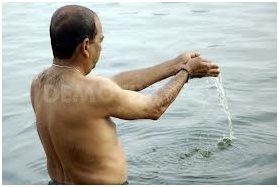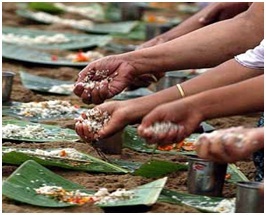HINDU SAMSKARAS
Hinduism is a way of human life, a path of eternal spiritual discipline, the sanatan
dharma. Recognizing the needs of human beings during their lifetimes, the
ancient sages have put forward a fourfold ideal to be striven for by every member
of the society. This is called the purusharthas or the ends to be achieved
in life. They are dharma, artha, kama and moksha i.e. duty or righteousness,
wealth, bodily desires and liberation from transmigratory existence respectively.
Unless some higher norms and standards are prescribed there cannot be any fairness
in playing the game of life to achieve these ends and as a consequence jungle law
only will prevail. It is these rules or norms that go by the omnibus term “dharma”
for which there is no English equivalent. For our purposes we will interpret this
term as duty or responsibility or obligation. Thus dharma is made applicable to
each member of the society according to the varna to which he belongs and according
to his stage in life.
Hinduism believes that a human being gets purified and refined by undertaking certain
rites or rituals referred to as samskaras which are generally taken as
sixteen in number (sodasa-sasamskaras). The Hindu scriptures do not consider
birth as the starting point of life. It goes farther back since the incident of
birth is primarily conditioned by heredity and parentage. Keeping this in mind,
the samskaras for a person start from the time of his conception (Garbhadhana)
and end with cremation rites (antyeshthi).
The antyeshthi stands for all the post-death ceremonies performed by the
son of the deceased for his future welfare and to be freed from the debt or obligation
he owes to his parents. These post-death rituals do not come to an end with the
conclusion of the prescribed number of days of the mourning period immediately following
the death but extends throughout the lifetime of the surviving son, though on a
smaller scale.
Apart from the ceremonies to be performed every month following the death culminating
in the first anniversary of the death, Hindu Dharma prescribes that the forefathers
should be worshipped thereafter also. When they leave this world it becomes the
Vedic duty of their descendants (sons) to worship their departed souls on a daily
basis apart from the specific days like New Moon day (amavasya), Eclipse
Days (grihan), Parva Kala (Uttarayana, Dakshinayana), Pushkara Days, on
the specific day (thithi) of their death, on visiting any Theertha Kshetras etc.
Among these rites the important ones to be undertaken by the son in honor of his
deceased parents and forefathers are Tarpan on every newmoon day (Amavasya),
Shraaddh on each anniversary of the deceased and most importantly the rites to be
performed during the Pitrupaksh.
RUNA TRAYA: CONCEPT OF THREE DEBTS
A discerning person will naturally seek an answer to the question why at all these
rituals are required to be performed. Hinduism answers this query when it says that
every person who is born is under five runas or debts to his manes and
others from whom he derives benefit as a member of the society. They are called
pancha maha runas (five great debts) to clear which he has to undertake
pancha maha yajnas (five great sacrifices). They are 1. deva yajna
(sacrifice to the gods), 2. pitru yajna (sacrifice to the manes or forefathers),
3. rishi yajna or brahma yajna (sacrifice to the sages learned in the Vedas),
4. nriyajna (feeding the visiting hungry human beings) and 5. bhuta yajna
(feeding the animals). There were no schemes of loan waiver or writing off of the
debt in those days.
It was considered that by performing these sacrifices daily, the householder is
actually repaying the debts to the divine beings and the society from whom he has
received help and sustenance. They also help him in offsetting the sins he might
be committing knowingly or unknowingly during his daily life.
Among these the first three types of debts viz.1. debt to the gods (deva runa),
2. debt to the forefathers (pitru runa) and 3. debt to the sages (rishi
runa) are given priority which is called runa traya. The idea
of three debts under which every human being is born has been found in the Rig Veda
(8.32.16; 6.61.1), Taitriya Samhita (6.3.10.5) and the Satapatha Brahmana (1.7.2.11).
The first type of debt is repaid by the performance of yajnas or Vedic
sacrifices to the gods; the second by marrying according to dharma, begetting
successors and doing shraaddhas to the deceased ancestors and the third
by study of the Vedas. We are concerned in this essay with the rituals relating
to the deceased forefathers for clearing pitru runa.
PITRU LOKA
The Sanskrit word ‘pitr’ becomes ‘pita’ in the
singular and ‘pitarah’ in the plural; the former means ‘father’,
the latter is used in several senses like forefathers or ancestors occupying their
own world called Pitruloka. The most common meaning as used in Shraaddhas
is three generations of ancestor’s viz. father, grandfather and great-grandfather.
In Hinduism, the pitrus (forefathers or manes) are always respected. Normally,
once a year at least, the descendents are expected to pay homage to them through
religious rites known as ‘Shraaddh’. It is believed that even
as the descendents are eager to appease their forefathers, the pitrus too
are eager to receive such appeasement. The Markandeya Purana describes such instances
of eagerness on the part of the pitrus to get good food (in the Shraaddhas),
to receive oblations of water during Tarpans and to get a Shraaddha
performed at holy places like Gaya. For these acts of offering them food etc. they,
in turn, bless their descendents and are pleased if they become Vedic scholars and
devotees of Vishnu. It is believed that during the performance of shraaddhas
these pitrus accept the offerings by assuming the form of birds or by entering
into the invitee brahmanas through their subtle bodies.
In this context the following verse from the Bhagavad Gita where Arjuna laments
about the ancestors losing their status on account of their being deprived of offerings
to them is relevant.
sankaro narakaayaiva kulaghnaanaam kulasya cha
patanti pitaro hyeshaam luptapindodaka kriyaah // 1.42 //
Admixture of castes leads the family and the slayers of the family to hell because
the spirits of their ancestors fall, deprived of the offerings of rice and water.
We find from the Upanishads and the Bhagavad Gita that the ancient Hindus believed
in two paths by which the soul of a departed person could go either to the Brahma
loka or to the Chandra loka. The former is called Devayana
and the latter is known as pitruyana. The Rig Veda (10.14.2 and 7) mentions
the pitruloka as a place where one’s departed ancestors live. The
Brihadaranyaka Upanishad (6.2.16) considers Pitruloka as a station on the
path of Pitruyana (the path of manes).
TARPAN
The word ‘tarpana’ means satiating or satisfying. It implies
the rites relating to satisfying the departed souls particularly one’s forefathers.
It consists of standing in water after bathing in a river or tank and offering water
thrice taking it in the joined palms of hand, with appropriate mantras
to all beings of creation from Brahma down to the blade of grass. Manusmriti (2.176)
says that Tarpan to devas, pitrus and rishis is a compulsory part
of the daily routine of every brahmacharin. The water may be mixed with
gingelly seeds (til). Tarpana is said to satiate the gods, manes and sages
to whom it is offered.

SHRAADDH
Hinduism considers death as a transition from one life to another. It believes that
the disembodied soul badly needs help and succor from its descendents, not only
during the period following the death of the physical body but also during its journey
to the other worlds. It is here that come the role of the various rites performed
immediately after death and also other rites that are repeated every month for a
year or even every year thereafter. These rites generally go by the name ‘shraaddh’;
the literature on the subject of shraaddh is enormous.
The word ‘shraaddh’ is generally taken to mean after-death
rites and subsequent ceremonies. ‘Shraaddh’ is performed by
a competent descendent of the deceased ancestors with shraddha or faith.
It is done for the benefit of three generations of ancestors viz. father, grandfather
and great-grandfather. It has to be performed at the appropriate time (afternoon
or aparahna) and place (preferably holy places like Gaya, Prabhasa, Prayag,
Varanasi, Ujjain, Kurukhetra, Badrinath etc.) as determined by the sastras
and family traditions. It may be accomplished by giving either cooked food or uncooked
articles of food or gold or money to worthy brahmanas. Generally for the
majority of the people pinda daana – offering cooked rice-balls to
the pitrus is very important in this ritual. The entire ritual is then
dedicated to Lord Narayana with a prayer for forgiveness for the faults that might
have unknowingly crept in.
The original concept of performing the ritual of Shrāddha was conceived
by Sage Atri, the son of Lord Brahma. Sage Atri narrated the ritual of Shrāddha,
as laid down by Lord Brahma to Nimi, one of His descendants. This established ritual
has continued till today. Manu was the first one to perform the ritual of Shrāddha.
Hence he is called the deity of Shrāddha.
According to Ramayan when Lord Rama, Goddess Sita and Lakshmana were staying in
the forest, Bharat met and appraised them about the death of their father. After
hearing this sad news Lord Ram performed the ritual of Shrāddh for his
deceased father.
Pinda Daana
Pindapradaana or simply pinda daana occupies an important place
in the post-death ceremonies. Pindas are rice-balls prepared by mixing
cooked rice with other articles of food left over in the cooking vessels after the
invitee brahmanas have been fed. Three such balls are made which are kept
on the ground on a banana leaf or a dried leaf covered with darbha or kusha
grass and til and offered to the three generations of pitrus (who
are believed to accept them by assuming the form of birds (crows) or animals such
as cows or through water in the flowing rivers like Ganga or sacred tanks and lakes
like Pushkar or brahmakund at Kurukshetra or brahmakapal at Badrinath).
